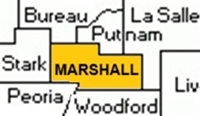
This, as also each place noticed below, is one of the defunct
towns whose annals belong to the disastrous period of 1836-7. It
occupied a fine position on the river bank nearly two miles
above Henry, where there is a superior steamboat landing,
accessible at all seasons of the year. A fractional quarter
section was laid off here on the 20th of June, 1837, by Robert
Latta [Col. Latta died in Webster Sept 23d, 1837, “much lamented
by all who knew him,” as his obituary states.], Alvin Dascomb,
Walton Plato, and Major P. McAllaster, Webster being thus
“ushered into existence by the skilful hand of the County
Surveyor and his co-workers." Many lots were sold at high
prices, for that early day ; and improvement went forward
rapidly. By the early part, of August a steam saw and grist-mill
was in progress, with an engine already on the spot; several
dwellings had been put up, and fifteen or twenty others were
under contract In the autumn it contained about thirty houses
and a population of more than a hundred. The place had grown
into a flourishing village while its sister town, Henry, had
scarce a house upon its site. No branches of business were
carried on, however, except by a blacksmith and Josiah E. Hayes,
who kept a small grocery store.
On the 22d of June, 1837, Webster was honored with a visit from
its great namesake, the " godlike Daniel," who, accompanied by
his wife and daughter, was then passing up the river on the
steamboat Frontier, escorted by the Wave. He stepped ashore at
this landing, and conversed freely with the few inhabitants who
had thus soon settled upon the site. Upon being asked his
opinion of the rising town, he stated that he thought it "a
very handsome place for a farm," but was quite reserved in his
commendations of it as a town. The steamers remained at this
place an hour or two, during which time the distinguished
statesman was the centre of attraction.
Webster was a short-lived town. The summer and autumn of 1838
proved sickly; it was alleged that the proprietors did not
fulfil their engagements; and the inhabitants began to desert it
rapidly. The last one left in 1842; the mill never got into
operation; the houses were gradually removed or destroyed; and
it ceased to be considered a town-site after 1843, when it was
probably vacated. [* The readers of this work must not suppose
that only those “paper towns” were vacated which are so
mentioned. In 1841, a law was passed which enabled the
proprietors of towns, parts of towns, or additions, to vacate
them without the intervention of the Legislature. A number of
town sites noticed in the text may have been vacated in this
manner, which fact has thus escaped the knowledge of this
author.] A few scattered foundations, and some shallow cavities
in the soil, are all that remain to mark where it stood.
Transcribed 04 Feb 2012 from History of Putnam and Marshall Counties, by Henry Allen Ford, 1860
| Bureau Putnam La Salle | |||
| Stark |
 |
||
| Peoria | Woodford | ||

